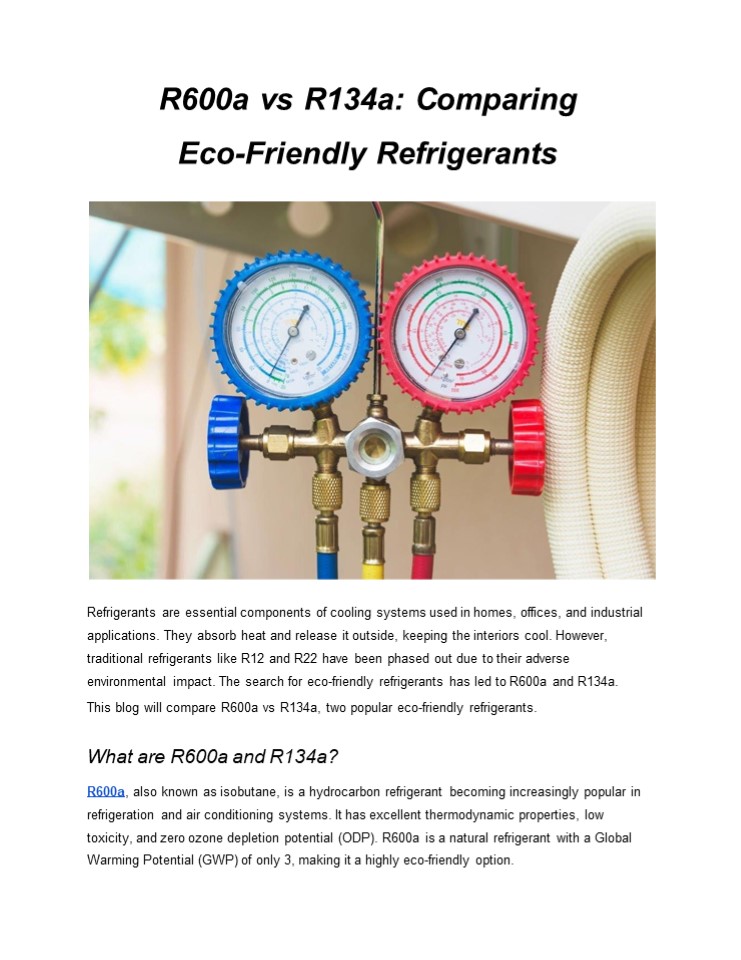R600a vs R134a: Comparing Eco-Friendly Refrigerants - PowerPoint PPT Presentation
Title:
R600a vs R134a: Comparing Eco-Friendly Refrigerants
Description:
Refrigerants are essential components of cooling systems used in homes, offices, and industrial applications. This blog will compare R600a vs R134a, two popular eco-friendly refrigerants. – PowerPoint PPT presentation
Number of Views:2
Title: R600a vs R134a: Comparing Eco-Friendly Refrigerants
1
R600a vs R134a Comparing Eco-Friendly
Refrigerants
Refrigerants are essential components of cooling
systems used in homes, offices, and industrial
applications. They absorb heat and release it
outside, keeping the interiors cool. However,
traditional refrigerants like R12 and R22 have
been phased out due to their adverse
environmental impact. The search for eco-friendly
refrigerants has led to R600a and R134a. This
blog will compare R600a vs R134a, two popular
eco-friendly refrigerants. What are R600a and
R134a? R600a, also known as isobutane, is a
hydrocarbon refrigerant becoming increasingly
popular in refrigeration and air conditioning
systems. It has excellent thermodynamic
properties, low toxicity, and zero ozone
depletion potential (ODP). R600a is a natural
refrigerant with a Global Warming Potential
(GWP) of only 3, making it a highly eco-friendly
option.
2
On the other hand, R134a is a hydrofluorocarbon
(HFC) refrigerant widely used in air
conditioning and refrigeration systems. It has a
GWP of 1300, which is much higher than R600a.
R134a has a lower toxicity level than traditional
refrigerants, making it safer for human
exposure. However, it significantly impacts the
environment and contributes to global
warming. Performance Comparison R600a has
excellent thermodynamic properties that make it a
highly efficient refrigerant. It has a higher
volumetric cooling capacity and a lower
compressor power requirement than R134a. R600a
also operates at a lower discharge temperature,
which reduces the risk of compressor breakdown
due to overheating. However, R134a has a better
refrigeration capacity and cooling efficiency
performance. It is more stable and less prone to
flammability, making it a safer option for use in
air conditioning systems. R134a also has a wider
range of operating temperatures, making it
suitable for use in different climate
zones. Environmental Impact of R600a
R134a Using R600a as a refrigerant benefit the
environment due to its low GWP and zero ODP. It
has a minimal impact on the ozone layer and does
not contribute significantly to global
warming. R600a is also a natural refrigerant,
which means it is not synthetic and does not
contain harmful chemicals that can harm the
environment. On the other hand, R134a has a high
GWP and contributes significantly to global
warming. It is a synthetic refrigerant
containing hydrofluorocarbons, potent greenhouse
gases. The use of R134a has been phased out in
many countries, and efforts are being made to
replace it with eco-friendly alternatives. Safet
y Considerations R600a and R134a are safe for
refrigeration and air conditioning systems.
However, R600a is flammable, posing a risk if
not handled properly. The use of R600a requires
specialised equipment and installation
techniques to ensure safety. On the other hand,
R134a is
3
- non-flammable and less hazardous to handle,
making it a safer option for air conditioning
systems. - Advantages and Disadvantages
- When it comes to comparing R600a vs R134a, both
refrigerants have their advantages and
disadvantages. Here are some of the pros and cons
of each refrigerant - Pros and Cons of R600a
- Pros
- Low GWP and zero ODP, making it environmentally
friendly - High energy efficiency due to excellent
thermodynamic properties - Non-toxic and safe for human exposure
- The natural refrigerant that does not contain
harmful chemicals - Cons
- Flammable and requires specialised equipment for
safe handling - Limited availability in some regions
- Lower refrigeration capacity than R134a
4
- Comparison of Advantages and Disadvantages
- When comparing the advantages and disadvantages
of R600a and R134a, the choice between them
depends on the specific application and
priorities of the user. If energy efficiency and
environmental impact are the top priorities,
R600a is the better option. However, if
refrigeration capacity and wide operating
temperature range are more important, R134a may
be the better choice. - Applications
- R600a and R134a are used in various applications,
including - Residential air conditioning Both refrigerants
are suitable for residential air conditioning
systems, although R134a is more commonly used due
to its higher cooling capacity. - Commercial refrigeration R600a is often used in
small commercial refrigeration systems, such as
beverage coolers and vending machines, while
R134a is used in larger commercial refrigeration
systems, like supermarkets. - Industrial applications R600a is also used in
industrial applications such as heat pumps,
chillers, and process cooling systems. R134a is
commonly used in industrial chillers and large
air conditioning systems. - Automotive air conditioning R134a has been the
standard refrigerant for automotive air
conditioning systems for many years, although
R600a is gaining popularity as an eco-friendly
alternative - Final Thoughts
- R600a and R134a are two eco-friendly refrigerants
with unique properties and benefits. R600a is a
natural refrigerant with a low GWP and zero ODP,
making it an environmentally friendly option. It
also has excellent thermodynamic properties and
is highly efficient. However, it is flammable
and requires specialised equipment for safe
handling. On the other hand, R134a has better
refrigeration capacity and cooling efficiency
performance. It is also non-flammable and less
hazardous to handle. However, it has a high GWP
and contributes significantly to global warming.
Both refrigerants have advantages and
disadvantages, and users must weigh them against
their specific needs to make an informed decision.































